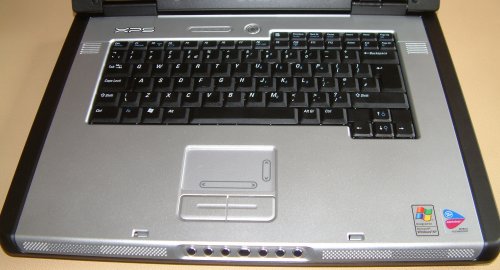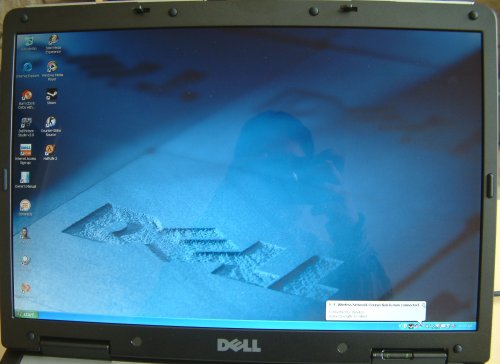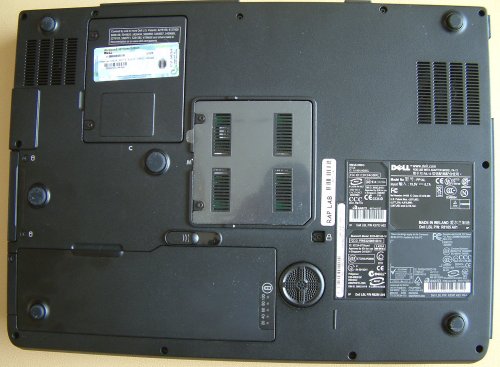Externals II, Internals

Opening up the lid, which only requires moving a single latch, shows just how large the laptop is. Dell's decided to go with a standard keyboard, that is, not add in a separate number pad on the side. The keys have just the right amount of travel and your forearms rest comfortably on the plastic sections directly in front of the keys.

The Inspiron XPS Gen 2 is only available with a 17-inch widescreen panel. Further, Dell reduces options by only offering the screen in a WUXGA format. That's 1920x1200 in normal money. 17-inch wide-aspect panels work equally well with 1680x1050 or 1920x1200 resolutions, and I'd opt for the latter if given a choice. The screen doesn't feature X-Black technology but is none the worse for it. It's clear, vibrant, and didn't suffer from the backlight problems that seem to plague a number of Dell-branded widescreen TFT displays. As you'll see later on, or if you've paid attention to the specs. on the previous page, Dell bundles in an awesome mobile GPU.

You can easily access the battery, RAM, and wireless modules from the bottom of the chassis. The 'Gen 2 uses a high-powered 80WHr 9-cell Lithium-Ion battery that has a handy charge indicator on the top. Simply press it and you get a rough idea of how much charge is left.
I've only spoken about the chassis and peripherals thus far. The Inspiron Gen 1 was not only a larger laptop with a standard 4:3 screen, it also used wattage-eating Pentium 4 CPUs housed on a laptop-sized i865PE motherboard. I mentioned that the Gen 2 is completely different from its predecessor. Dell's seen just how potent Intel's Pentium M CPUs have been, especially with respect to gaming (and that's what the Gen 2 is all about, folks) and added in a Pentium M 770 in this review model. That's a 2.13GHz-clocked, 2MB L2 cache, 533MHz FSB Dothan. You'll see just how fast it is in the benchmarks that follow. Another benefit, besides pure performance, is the Pentium M's low power requirement. Intel's spec. sheets hint at a TDP of only 27W for the 770 model. That translates to Dell using very quiet cooling for the CPU, much, much quieter than, say, chassis that incorporate Pentium 4 processors. Another benefit of the laptop-oriented Pentium M is better comparative battery life. Hell, in mobile terms, it's better than a Pentium 4 in almost every regard.
Dell's paired up the Pentium M 770 with an i915PM 'Sonoma' chipset that provides dual-channel DDR2 memory support and PCI-Express connectivity.

The review model shipped with 1GByte (2x512MB) of Samsung's PC4200 SODIMMs. You have the choice of upgrading to 2GB, but you had better take out that second mortgage. Dell's upgrading prices leave a lot to be desired. The Inspiron XPS Gen 1 was no slouch when it came to gaming. ATI's Mobility RADEON 9800 256MB provided reasonable clout at lower resolutions and only fell foul when tested with new-ish games that made heavy use of shaders. The 1920x1200 screen needed some serious GPU horsepower if you wanted to play games at the laptop's native resolution, so Dell signed up with NVIDIA and have teamed up the CPU with the impressive GeForce 6800 Go Ultra PCIe GPU. It features 12 pixel pipelines and 5 vertex shaders, with core speed humming along at 450MHz and 256MB of GDDR3 RAM at 1100MHz. Think about that speed in relation to desktop 6800 GT and 6800 Ultra models. Do the maths and you'll realise that it should benchmark in the vicinity of a GeForce 6800 GT 256MB card. Coupled in with the Dothan 2.13GHz CPU, the Gen 2 becomes the most formidable gaming laptop that we've ever seen, on paper at least.
Completing the hardware package is a 100GB 4,200RPM Fujitsu hard drive. The capacity is impressive, sure, but I'd rather take a smaller drive with a faster rotational speed. Dell even offers a single 100GB drive with a 7,200RPM rotational speed. That would have been just perfect for this model. The slower speed was mainly evident when loading up games.
Software
Dell's laptop bundles rarely differ between models. Our review model shipped with Windows XP Home w/SP2, Microsoft Works 7.0, Dell Media Experience 3.0, Sonic's RecordNow 7.3, PaintShop Pro Basic Edition, and Dell's Photo Album SE Basic. There's no carry case included in the price, which seems a mite stingy considering the £2099 asking price. Warranty, too, is a little on the shabby side for such an expensive laptop. Our review model's pricing was reflected with a 1-year next business day warranty. Upgrading this to a 3-year warranty costs a further £200 including VAT; not good. Keeping in with the company's JIT ethos, placing an order for a model kickstarts the manufacturing process. Expect to wait between 5-10 working days after your initial order has been placed.
Warranty
What happens if something goes wrong with your laptop. Dell's customer support is accessed by dialling an 0870 number that can cost up to 8p per minute. From considerable personal experience that emanates from dealing with Dell on at least a weekly basis, expect a minimum call time of 10 minutes. To Dell's credit, next business day has, in the past, meant just that. I still feel that a 3-year warranty should be standard, even if the second and third years are back to base. Feel free to share your experience of Dell's customer support in our forums.
Overall impression
The Inspiron XPS Gen 2 scores highly in a number of areas. Build quality is pretty good, the screen, CPU and graphics card are all fantastic choices, and, thanks to considered cooling and choice of components, the machine never produces more than a background humming sound, even with graphics card and CPU running at full chat. At an educated guess, the laptop consumes no more than 75W when running in full power mode. That's less than a Pentium 4 Prescott CPU. That's why Dell bundles in a modest charger that's rated at up to 130W.









